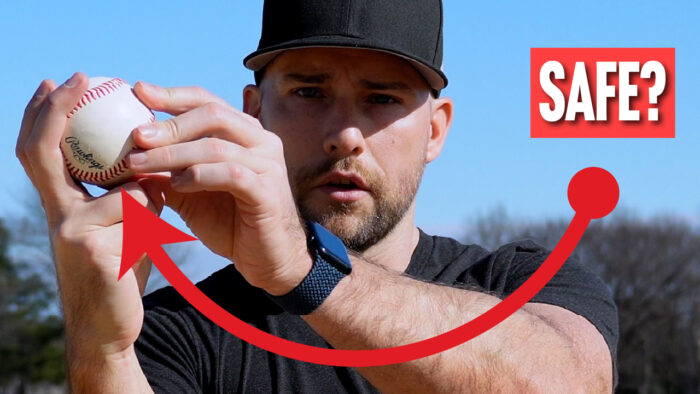*This article may contain product links which pay me a small commission if you make a purchase. Learn more.
Baseball is a sport that has been around for over a century, and continues to capture the hearts of young boys and girls each year.
Yet, it’s fraught with myths – especially when it comes to pitching, pitch grips, and arm health.
One of the most popular pitches in baseball is the curveball, which has been the subject of much debate regarding its safety. The curve is the first breaking ball most kids learn (rather than the slider), and many parents are afraid that their kid will hurt their arm throwing one.
Is there actually a safer way to throw a curveball?
Some coaches advocate for alternate curveball grips — such as the slip pitch — that promise a “safe” curveball – one free from stress that can be thrown at any age. But is this actually a truthful claim?
Many coaches and parents claim that there is a safe version of the curveball, but is this really true? In my video below, I addresse this topic and dispel the myth of the safe curveball or “slip pitch”.
There is NO Safer Version of the Curveball. Period.
Sorry, folks, but a curveball is a curveball.
👉 That said, curveballs aren’t some type of evil, ultra-stressful pitch, either! I’m NOT advocating that pitchers shouldn’t be allowed to throw them. I have guidelines for when I believe the curveball is safe to learn and use.
Research shows that fastballs and curveballs are about the same when it comes to stress. And so, the goal here isn’t to villify curveballs, but rather the shine light on the fact that there isn’t any proven way to reduce stress from curveballs.
And the way you want to learn a curveball is the RIGHT way, not some temporary version.
So, let’s talk about arm stress in general.
The first thing to understand is that research has shown that the fastball, not the curveball, is the most stressful pitch on a pitcher’s arm.
From the research study above on pitch stress differences:
“Nearly all kinetic differences among pitch types occurred between the changeup and the remaining 3 pitch types.”
This just means that the only significant difference in the major four pitch types (Fastball, Slider, Curveball and Changeup) was found with the changeup – NOT the curveball. The curveball, slider and fastball all produce a similar amount of stress.
Where Pitching Arm Stress Comes From
This is because velocity is most highly correlated to arm stress, and the fastball is the fastest pitch in baseball. However, there is a correlation between breaking ball usage and arm pain, which means that pitchers who throw more breaking balls, including curveballs and sliders, report more arm pain than pitchers who don’t throw them.
However, the relationship between arm pain and curveball usage is confounded, meaning there are so many variables at play that it’s hard to pull them apart and identify a cause.
The Fastball is the Most Stressful Pitch
Although the fastball is the most stressful pitch on a pitcher’s arm, there is a correlation between breaking ball usage and arm pain. This is where the myth of the safe curveball comes in. Some coaches and parents claim that there is a safe version of the curveball that can be thrown without putting undue stress on the arm. However, this is simply a misunderstanding of what curveballs do to the arm and the position that’s relevant when you release a pitch.
Supination of the Arm is What Makes a Curveball Stressful on the Elbow
Whether it’s a “safe curveball,” a “slip pitch,” or a normal curveball, all curveballs involve supination of the elbow. This means that the elbow is turned inward, which puts the arm in a different position, where the forearm muscles that protect the UCL (ulnar collateral ligament) are less active. This increase in UCL stress could lead to injury over time, especially if a pitcher throws too many curveballs in a game. Regardless, the stress is similar among ALL curveball types – “safe” grips or regular.
In Summary: Safer Curveball Grips Aren’t Real.
In conclusion, the myth of the safe curveball is just that – a myth. While the fastball is the most stressful pitch on a pitcher’s arm, there is a correlation between breaking ball usage and arm pain.
All curveballs involve supination of the elbow, which puts significant stress on the arm and can lead to injury over time. As with any pitch, it’s important to use proper technique and not throw too many breaking balls in a game to minimize the risk of injury.
Want to Learn Good Pitching Mechanics?
Check out my online pitching courses here or click below – it walks you through good mechanics, pitch types and more.

